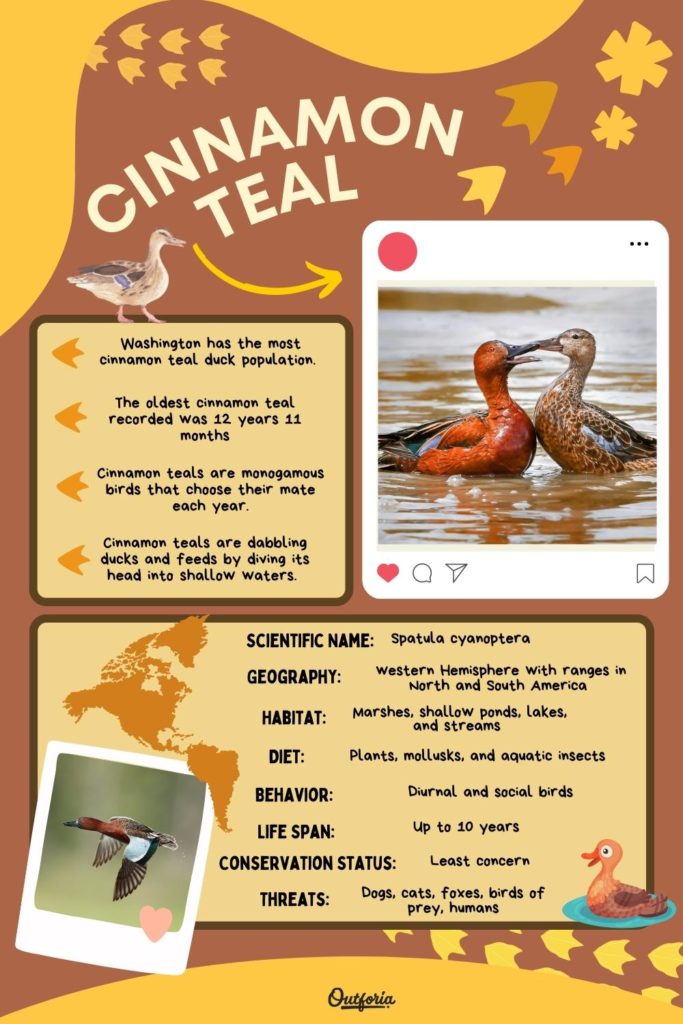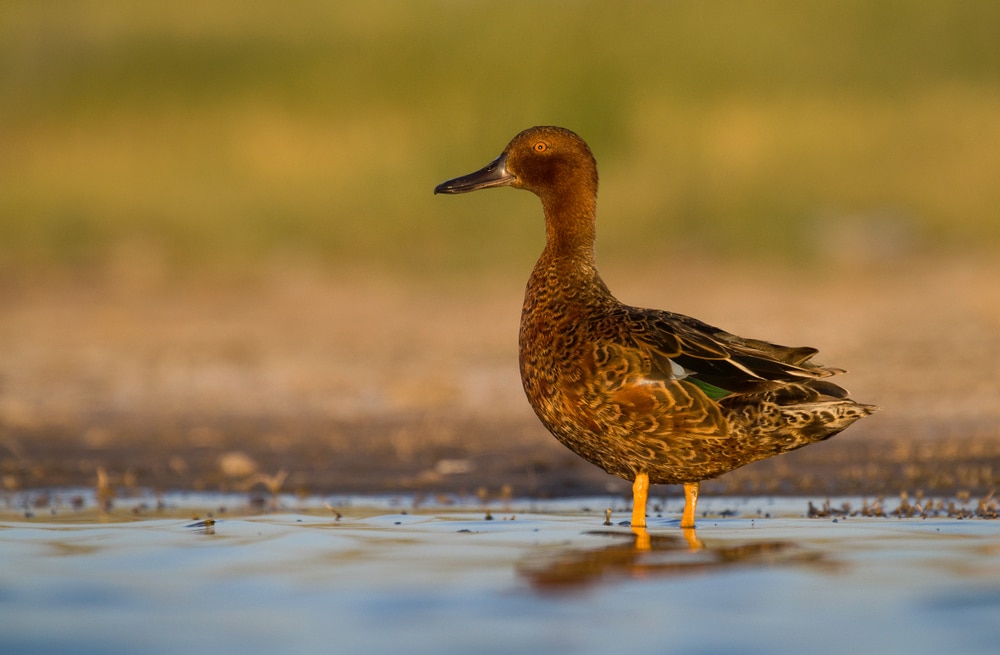Outforia Quicktake: Key Takeaways
- The cinnamon teal is a small, red-feathered duck native to North and South America, with the males displaying a distinct cinnamon coloring.
- They inhabit marshes, shallow ponds, lakes, and streams, and are diurnal, social birds.
- Their diet consists of plants, mollusks, and aquatic insects, which they feed on by dabbling in the water.
- They have a lifespan of up to 10 years and are currently listed as a species of least concern, despite habitat loss, pollution, and predation from various animals.
- The average cinnamon teal size is 16 inches (41 cm) long, with a 22-inch (560 mm) wingspan and weight of only 14 oz (400 g).
- Cinnamon teals play an essential role in their ecosystem by controlling aquatic insect populations and preventing vegetation overgrowth while also serving as food for predators such as coyotes, raccoons, and skunks.

share this image on your site
<a href="https://outforia.com/cinnamon-teal/"><img style="width:100%;" src="https://outforia.com/wp-content/uploads/2022/09/cinnamon-teal-infographic-0922-683x1024.jpg"></a><br>cinnamon teal <a href="https://outforia.com">Outforia</a>The cinnamon teal is a dabbling duck living in North and South America. They are handsome-looking, small ducks with an exciting name. The males have a cinnamon coloring, hence the name. They are unique among other duck species because of their nesting areas.
Did you know that male cinnamon teals are called drakes? Female cinnamon tales don’t have any other particular name; they’re just called ducks. Do you want to know more about this special duck? Keep on reading.
Classification

The cinnamon teal is a species of duck that belongs to the Anatidae family, the Spatula genus. Its scientific name is Spatula cyanoptera. This small duck also goes by names such as red teal and red-breasted teal.
Scientists recognize five subspecies:
- Northern cinnamon teal (Spatula cyanoptera septentrionalium)
- Tropical cinnamon teal (Spatula cyanoptera tropica)
- Borrero’s cinnamon teal (Spatula cyanoptera borreroi)
- Andean cinnamon teal (Spatula cyanoptera orinoma)
- Argentine cinnamon teal (Spatula cyanoptera cyanoptera)
Appearance and Size

The male cinnamon teal has exciting patterns. It has bright red eyes, a long dark bill, and rusty-red plumage. Their backs have a brownish color while the underwing is white. In contrast, the female has a brown body, brown eyes, and gray bill. The underparts are also brown with a white belly.
All adults have the same wing markings, and when they open their wings, they show their blue patches. Juveniles look like female ducks but with red eyes like male ducks.
The average cinnamon teal size is 16 inches (41 cm) long, with a 22-inch (560 mm) wingspan and weight of only 14 oz (400 g). They molt once in their first year of life and two more times as adults.
Geography, Distribution & Location

Cinnamon teal inhabits the western Hemisphere with ranges in North and South America. They rarely visit the east coast of America.
Only the northern cinnamon teal occurs in North America. The other four subspecies are native birds of South America.
They are migratory birds. They spend winters in northern South America and the Caribbean. Some ducks choose the Californian winter while others travel to Arizona. The Andean and Argentine cinnamon live in the Andes of South America.
Habitat and Climate Zones

Their ideal habitats include marshes, shallow ponds, lakes, and streams. They need low-growing reeds and various plants at the edges. The breeding and molting grounds include freshwater wetlands with vegetation.
When they migrate for winter, they choose similar freshwater wetlands and mangrove swamps. But, again, the preferred climate zones are temperate and tropical.
You may also like: 26 Swamp Animals & Their Fascinating Habitat
Diet

The cinnamon teal feeds by dabbling. It dives its head into the shallow water to snack on plants, mollusks, and aquatic insects. As omnivorous birds, they also nibble on the water surface with little bites. This way, they feed on small aquatic insects or forage through floating algae and plants.
A duck may follow another duck sometimes. The first duck stirs food by paddling the water, making it easier for the second duck to forage. Occasionally, they can look for food on land, but always stay near the water.
Behavior
As diurnal birds, most of their activities are during the day. They sleep at night on the water or on land near water. They usually sleep next to each other, with the male staying alert while the female sleeps.
They are quiet birds compared to other species of ducks. The females make loud quacking sounds. The males make “chuck” noises or whistling calls. Check the video above to hear the call of a cinnamon teal.
Red teals are social birds that travel in small flocks made up of pairs. For example, a group of cinnamon teals is called a coil or diving. The flock is peaceful during molting, from late summer through autumn. However, males remain dominant over females.
Mating

Cinnamon teals are monogamous birds that choose their mate each year. They form pairs starting late winter to early spring. However, monogamy is not for everybody. Some males mate with many females during this time.
The courtship season is intense! Males gather around one female to impress her. Red teal males display jump flights while the female watches. They also move their heads in various directions for the show. Males can also do preening movements and fake feeding movements.
An interested female will then swim in front of the male. She will reject other males by opening her bill or head-pumping. Once they pair up, the female starts building the nest.
From that moment on, the male is very protective of his new mate and becomes territorial. It will protect the area of the nest and his favorite resting spot. He will chase any intruder, including the same species as the blue-winged teal.
Nest sites are near water, hidden in thick vegetation. They’re usually placed on shallow grounds. The entries to nests are through tunnels made from plants.
The female lays up to 12 creamy-white eggs that hatch in approximately 25 days. Once the eggs hatch, the female guides the ducklings to the water.
Ducklings learn to feed themselves in less than 34 hours. Unlike most duck species, male ducks may stay with their partner even after the eggs hatch. They may even go with them when they leave the nest.
Ducklings can fly in about seven weeks after hatching. When they sense danger, the ducklings hide underwater. If a predator threatens a chick, the female diverts its attention by pretending she has a broken wing. Younglings can start reproducing once they reach one year old.
You may also like: How Do Ducks Mate? It’s Weirder Than You Think
Cinnamon Teals and Blue-Winged Teals

Cinnamon teals are closely related to blue-winged teals, and they usually interbreed together. The red teal is larger than the blue-winged teal, but it’s barely noticeable for untrained eyes. Their bill is also 10% longer, which looks like a shovel.
Females and juvenile cinnamon teals have warmer face tones than blue-winged teal species. Their pattern is more washed out with fewer contrasting features. They also have less intense eye stripes that don’t reach the nape.
Both species cover almost the same breeding grounds. The blue-winged teals’ range includes western North America. It spans from British Columbia in Canada to Texas, California, and Mexico.
Life Cycle and Lifespan

The average lifespan of a cinnamon teal is ten years. The oldest record is 12 years and 11 months, identified in 1982.
Population
Cinnamon teals are most abundant in North America. However, Partners in Flight database estimates a total of 380,000 remaining birds. Unfortunately, their numbers are declining due to habitat loss and pollution.
Conservation Status
The IUCN Red list adds the cinnamon teal as least concern as of 2016. The subspecies Borrero’s cinnamon teal might be extinct because it hasn’t been seen since the 1950s.
You may also like: All About The Mandarin Duck — The World’s Most Beautiful Duck
Threats and Predators

Since they are small mammals, they have many predators, such as cats, dogs, foxes, and raccoons.
In addition, other birds prey on them, like crows, ravens, gulls, and magpies. Humans also present a threat because of the cultivation and draining of the wetlands. When farmers divert the water for irrigation, they destroy their habitat.
Ecological Role

These birds play an essential role in their ecosystem. As they eat aquatic insects and mollusks, they help keep these populations in check. They also prevent vegetation from overgrowing. But at the same time, they are food for predators such as coyotes, raccoons, and skunks.
You may also like: All You Need To Know About The Bufflehead And Where To Find Them
Cinnamon Teal Fun Facts

Cinnamon Teal FAQs

What state has the most cinnamon teal?
Washington has the most cinnamon teal ducks. They choose this state for their breeding grounds.
Are teal ducks good to eat?
Teal ducks are good to eat because they are nutritious and contain high protein levels. The disadvantage is less meat due to their size. Out of all teals, the cinnamon species is not very tasty.
Why is cinnamon teal so rare?
The cinnamon teal is rare because it has two separate breeding zones in North and South America. Therefore, unlike other dabbling ducks, they never breed in the midcontinent.
Why is a teal duck called a teal?
Their color patterns contain a dark shade of greenish-blue colors on the males’ heads. Both sexes have this pattern on their wings.









